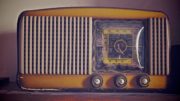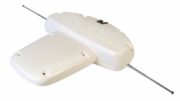When you search for the term “line of sight” you get a lot of confusing diagrams like the one above. Let’s be honest, that doesn’t help.
“Line of sight” is a much simpler idea and it’s one you can understand pretty easily when it comes to antennas and satellite television. If your antenna or dish is pointed straight at the broadcast source — at the tower or satellite — is there anything in the way? Really, there’s nothing more to it than that.
A much easier way of thinking about it
Think of it this way. If you were standing in one room and pointed yourself toward someone in another room, could you see them? Unless the walls were made of glass, you couldn’t. You don’t have a “line of sight” to them. On the other hand, if the two of you were in an open field, of course you could see each other. You would have a “line of sight” to them.
I’ll admit that there are a few things about antennas and satellite systems that make things a bit more difficult…
TV Antennas and Terrestrial Reception
When you’re trying to get to a tower far in the distance, it’s pretty hard to know if you actually have good line of sight. You may be able to see a mile or two, but beyond that it may be hard to know if you can see those antenna towers. If they’re at the top of a mountain or on top of the tallest building in the area, you can feel pretty confident, because you can actually see where you’re pointing. In the suburbs it can be a little harder. You might be able to see that you have some trees in the distance, but you might not know whether or not that stops you from getting a broadcast signals.
There’s also the concept of beam width, which means how much of the area in front of the antenna is actually good for picking up signals. This tends to be about 30-45 degrees except in special cases, so it’s kind of like putting blinders on; you really can only see right in front of you.
The last thing you have to worry about with antennas is the actual planet working against you. Take a look at this:

See, at some point the antenna signal is actually absorbed by the earth even if you’re pointing in the right direction. Even with perfect line of sight you won’t get a signal 125 miles away because the earth’s gentle curve is enough to prevent it.
Satellite Considerations
Pointing a satellite is actually easier because you don’t need to worry about line of sight 10 miles away. You need to make sure there are no trees or buildings that would affect the satellite reception, and that’s about it. It would be incredibly easy, except modern satellite TV dishes need to be aimed to see signals from two or three locations at the same time. This may mean that you think you’ve got a good line of sight but you don’t. You need to check to the far left and right of the dish. The best thing to do is to look about 20 degrees in either direction to be safe. Make sure there’s nothing there to stop you from getting a nice strong signal.
Of course there are other considerations with satellite TV. Think about it. You’re looking for an extremely weak signal coming from 22,000 miles away. There are challenges because of that, but that’s a subject for another article.
In the meantime, be sure to shop at SolidSignal.com! It’s a perfect place to get all your antenna and satellite accessories.





